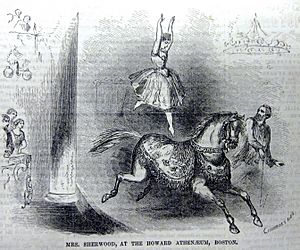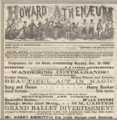Howard Athenaeum facts for kids
The Howard Athenæum (1845–1953), also known as the Old Howard Theatre, was a very famous theater in Boston, Massachusetts. It opened in 1845 and was a big part of Boston's culture for many years. It finally closed its doors in 1953. Sadly, after a fire in 1961, the building was torn down in 1962.
Contents
A Look Back at the Howard Athenæum
The Howard Athenæum was one of Boston's most well-known theaters. People loved it so much they called it "The Old Howard."
From Church to Playhouse
The building started as a church in 1843. It was built by a group called the Millerites. They believed the world would end in 1844. When that didn't happen, the group moved on.
In 1845, the church building was turned into a theater. But just a few months later, it burned down! A new theater was quickly built in 1846. It was designed by Isaiah Rogers and looked unique with its Gothic-like style. This new building was made of strong granite and could hold 1,360 people. It reopened on October 5, 1846, on Howard Street in an area now called Boston's Government Center.
Early Days of Entertainment
For many years, the Howard Athenæum was one of Boston's top theaters. It was known for hosting famous touring actors. The theater offered many types of shows, including:
- Opera
- Plays (tragedies and comedies)
- Comedy shows
- Vaudeville (a mix of acts)
- Minstrel shows
- Magicians
Famous actors like Edwin Booth and Charlotte Cushman performed there. Even a young John Wilkes Booth acted on its stage, playing Hamlet. The Howard also became famous for its opera shows. For example, Verdi's Ernani had its first American performance there in 1847. This was a big moment for Italian opera in Boston.
When the theater first opened, a newspaper called the Boston Courier said it was a "very convenient and handsome theatre." They were sure it would be "crowded tonight to the utmost strength of its capacity."
For its first 20 years, the Howard mainly showed ballet, opera, and serious plays. On its very first night, it opened with a play called The School for Scandal. Just a few months later, in February 1846, during a play called Pizzaro, the scenery caught fire, and the building burned down again! But the theater quickly rebuilt and reopened on October 5, 1846, with another play, The Rivals.
Important Moments and Changes
The Howard Athenæum saw many important events and changes over its long history.
Famous Performers and Big Challenges
Many superstar performers appeared at the Howard. One was the comedian William Warren, who was considered the best comedian in the country for years.
The theater also faced challenges. In 1853, a black anti-slavery activist named Sarah Parker Remond bought a ticket for an opera. When she arrived, she refused to sit in a separate section for black people. She was forced out of the theater. Sarah Parker Remond later sued the theater managers and won her case. She received $500, and this helped fight against segregation in public places.
A Shift to New Shows
By the late 1860s, the Howard Athenæum started to lose some of its audience to other popular theaters. So, it began to offer different kinds of shows. In 1869, it started showing vaudeville, which was a mix of musical acts, comedy, and dancing.
By the end of the 1800s, the theater focused completely on lively shows with music, comedy, and dancing. Famous performers like Ann Corio, Sally Rand, Gypsy Rose Lee, and comedians Fanny Brice and Sophie Tucker appeared there.
The Howard Athenæum was torn down in 1953. Today, a sign from "The Old Howard" is kept safe at the Emerson Umbrella in Concord, Massachusetts.
Actors Who Started at the Howard Athenæum
Many talented actors began their careers at the Howard Athenæum.
- Fanny Davenport (1850–1898) was an American stage actress. She was born in London but grew up in Boston. When she was just seven years old, she performed at the Howard Athenæum.
- Barney Fagan (1850–1937) made his first professional appearance in Boston at the Howard Athenæum in 1860. He played a Cabin Boy in a play called "Pilot of Brest." He stayed at the theater for several seasons.
- Nathaniel Carl Goodwin (1857–1919) was an American actor and vaudeville performer from Boston. He first appeared at the Howard Athenæum in 1874 as a newsboy in a play.
- William Edward Sheridan (1839–1887) was born in Boston and started his acting career at the Howard Athenæum in 1858. He became known for playing villains and serious characters.
- Denman Thompson (1833–1911) was an actor whose family lived in New Hampshire. He made his first appearance on stage at the Howard Athenæum in Boston in 1850.
Images for kids






